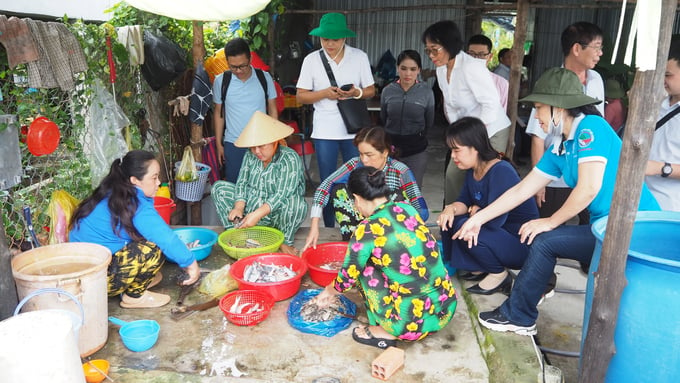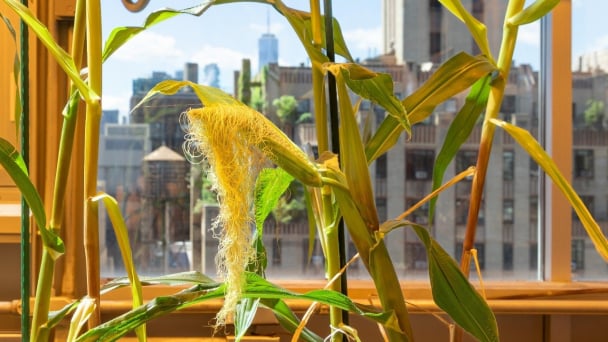June 5, 2025 | 17:37 GMT +7
June 5, 2025 | 17:37 GMT +7
Hotline: 0913.378.918
June 5, 2025 | 17:37 GMT +7
Hotline: 0913.378.918

The project "Protecting the climate and mangroves combined with income improvement for vulnerable communities" is implemented in the area of Ca Mau Cape National Park and Tam Giang Protection Forest Management Board. Photo: Trong Linh.
"Protecting climate and mangroves combined with income improvement for vulnerable communities" is a project implemented by the Center for Sustainable Rural Development in the area of Ca Mau Cape National Park and Ca Mau’s Tam Giang Protection Forest Management Board.
The project aims to strengthen biodiversity protection, develop mangrove forests, contribute to promoting carbon sequestration, enhance climate resilience, ensure sustainable livelihoods and social inclusion for poor and vulnerable communities in the Mekong Delta.
Mr. Tran Van Thuc, Deputy Director of Ca Mau Department of Agriculture and Rural Development, highly regarded the project's success as well as the achieved results during the two years running the project. Thanks to the support and good coordination of the Department of Agriculture and Rural Development, stakeholders and people in the locality, the project has brought many positive impacts on the forest management and protection work as well as the development of livelihoods for those living in the national park and protection forest management staff.

After 2 years of implementation, the project has helped the Forest Management Board to propagate and coordinate forest management and protection, thereby improving people's living conditions. Photo: Trong Linh.
Mr. Ly Minh Kha, Deputy Director of Ca Mau Cape National Park, said, “In my perspective, the project's activities in the second year have been much more efficient, helping U Minh Ha National Park in its work of information dissemination, coordination in forest management and protection. As a result, people's livelihoods are improved. In particular, the 2-phase shrimp model has received a lot of positive response from the people, initial replication has shown good results."
Having achieved such results, Mr. Kha highly appreciated the efforts of the project staff from the SRD center and the Women's Union of Ca Mau during the implementation at localities. In the near future, Ca Mau Cape National Park will continue to work with relevant units to have assessments, adjust restrictions, be ready to coordinate and deploy meaningful activities as a response to the project’s progress and responsibility to the people in the project area.

After 2 years of implementing the project, people’s responsibility in coordination, management and protection of mangroves has been significantly improved. Livelihood models under the forest canopy open up a number of new directions in household economic development for communities living near the forests. Photo: Trong Linh.
“The project's activities have contributed to raising awareness and responsibility for forest protection among the members of seven forestry groups and local people living in the forest area. In 2022, the project supported the management board to plant 5 ha of new forest and an additional 27 ha of mangroves. These areas will have great significance to forest restoration and development work in the future,” said Mr. Nguyen Quang Khai, deputy head of the Tam Giang Protection Forest Management Board.
After 2 years of implementing the project, people’s responsibility in coordination, management and protection of mangroves has been significantly improved. Livelihood models under the forest canopy open up a number of new directions in household economic development for communities living near the forests.
There remain a number of livelihood models that are not effective due to increasingly erratic weather conditions, leading to risks during the piloting of livelihood models. Despite certain difficulties, the project still provides sufficient assistance and contribution to raising awareness about forest protection and finding sustainable livelihood solutions. Thanks to the project, people with conditions for economic development under the mangrove canopy can have more chances to increase their income and better their living conditions.
Director of the Center for Sustainable Rural Development Vu Thi Bich Hop said, “In the coming period, it is deemed essential to continue to maintain the good progress after two years of implementing the project and make full use of the achieved results. The project will particularly focus on objectives related to forest protection and development, enhancement of mangrove carbon stocks, and policy advocacy plus livelihood improvement. The project’s achievements can be considered a great condition for the project to propose further support from sponsors to implement activities in the next phase.”
Translated by Samuel Pham

(VAN) Technology is redrawing the map of Vietnamese aquaculture: more modern, greener, and more sustainable.

(VAN) Novel process harnesses machine learning to reveal groups of genes that determine how efficiently plants use nitrogen.

(VAN) Several scientists and farmers are experimenting with soil treatment in some key durian-growing regions such as Cai Lay (Tien Giang), Dak Song, Gia Nghia, and Dak R’lap (Dak Nong).
/2025/05/25/4127-3-073637_820.jpg)
(VAN) Thanks to the promotion from an FAO-implemented project, vegetable production in greenhouses in Moc Chau has seen strong development, from 1.5 hectares in 2021 to nearly 50 hectares in 2024.

(VAN) FAO has recently supported USD 140,000 to implement the project 'Risk mitigation human-animal interface risks through disease control initiatives in pig farming.'

(VAN) The People's Committee of Tra Vinh province has approved an adjustment to the investment policy for the Green Hydrogen Plant project, increasing its area to approximately 52.76 hectares.
![Reducing emissions from rice fields: [2] Farmers’ commitment to the soil](https://t.ex-cdn.com/nongnghiepmoitruong.vn/608w/files/news/2025/05/05/dsc08881jpg-nongnghiep-140632.jpg)
(VAN) Clean rice cultivation model in Thuong Tan commune, Bac Tan Uyen district, is assisting local residents in achieving sustainable agriculture by substantially reducing costs, increasing productivity, and protecting the environment.